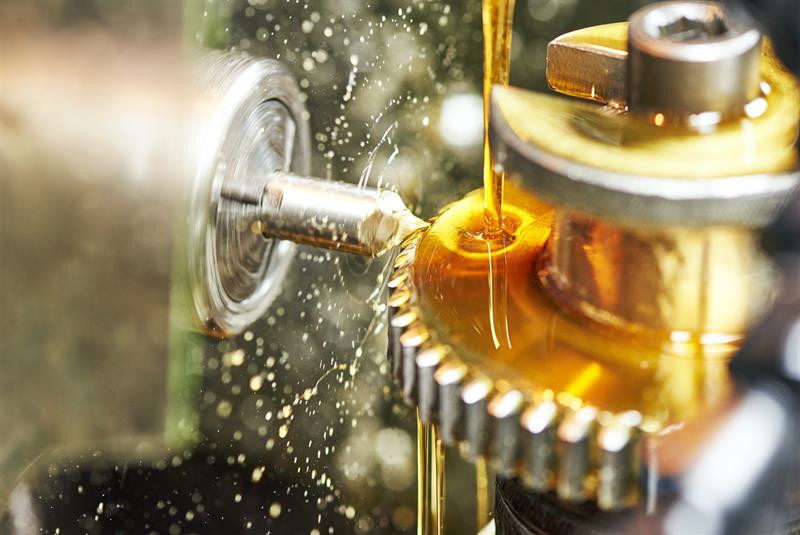In this article, cutting oil specialist Tameson looks at how solenoid valves can precisely define the amount of cutting fluids used and save significant amounts of money for the end-user. We also look at the different types of cutting fluids and how the choice of fluid affects the choice for a solenoid valve.
How does a solenoid valve work
A solenoid valve uses electricity to create a magnetic field that opens or closes a valve. As these valves can be activated almost immediately they are ideal for dosing liquids in very precise quantities. Typically, there are three main types of solenoid valves. Those that are normally open, those that are normally closed, and those that are bi-stable.
- Normally open solenoid valves: Normally closed solenoid valves are closed when they are de-energized and media cannot pass through them. The electromagnetic field created by sending current to the coil overcomes the spring force to force the plunger upward. This unseats the seal and allows the media to flow through the valve.
- Normally closed solenoid valves: Normally open solenoids are open when they are de-energized, allowing media to pass through. By sending current to the coil, an electromagnetic field is created that pushes the plunger downwards overpowering the spring force. When the seal is seated in the orifice and closed, the valve prevents media from flowing through it.
- Bi-stable solenoid valves: A bi-stable or latching solenoid valve can be switched by a momentary power supply. It will then stay in that position with no power. Therefore, it is not normally open or normally closed as it stays in the current position when no power is applied. They accomplish this by using permanent magnets, rather than a spring.
Solenoid valves can control the application of liquids in very precise quantities and are therefore perfect for the MQL or minimum quantity lubrication technique.
Solenoid valves and minimum quantity lubrication
The minimum quantity lubrication technique (MQL) is a process where cutting fluids are applied in drastically smaller amounts than flood applications. The process is also known as near-dry machining or mist spraying.
Cutting fluids are applied with a flow rate of 10-100 ml/h by a solenoid valve. The fluid is either mixed with compressed air and applied as a mist during the cutting process. Or, in a system that does not use air, a precise measure of liquid is delivered under pressure to a nozzle and applied as micro-droplets.
Due to the low amounts of cutting fluid that is used for this process it is both much more environmentally friendly and cost effective. Because solenoid valves can be adjusted to deliver exact measurements the mixture settings can be easily changed.

During metal-working and machining processes, cutting fluids serve as both lubricants and coolants. Flooding, fluid jets, or mist spraying (MQL) can all be used to apply cutting fluids. A solenoid valve that is normally closed is therefore an ideal piece of equipment to dispense the cutting fluid.
However, there are several different types of cutting fluids that all have different chemical properties. Care should therefore be taken in the choice of solenoid valve material. Use a material selection guide to compare the choice of cutting fluids with the correct solenoid valve.
Soluble oil emulsions are the least expensive and most common type of cutting fluids used in machining operations. They have good cooling and average lubricating properties. They are best suited to light cutting operations. They are formed by the combination of water and mineral oils. Emulsifiers such as sodium sulfonate allow the oil to mix with water by decreasing the water's surface tension.
Mineral oils are petroleum-derived hydrocarbons that are obtained through refining crude oil. To reduce tool wear, they may contain additives, such as chlorine, phosphorus, and sulphur. However, take care with chlorine as an additive, as this will exclude the use of stainless steel solenoid valves.
Synthetic fluids are water-based fluids containing mineral and petroleum-based oils. These fluids are produced through a solution of inorganic and organic chemicals in water and the addition of several additives. These additives include lubricant additives, rust inhibitors, and corrosion inhibitors. It is important to check which additives are included in the cutting liquid to ensure chemical compatibility.
Semi-synthetic fluids combine synthetic fluids with water-based fluids and soluble oil emulsions. A mixture of 5-50% mineral oil, additives, and chemical compounds dissolves in water to form microemulsions with particles of 0.1-0.01mm in size. Semi-synthetic fluids combine the properties of both synthetic fluids and soluble oils.










